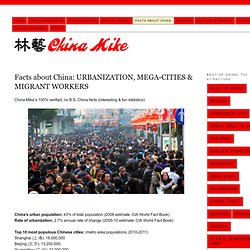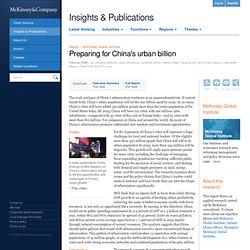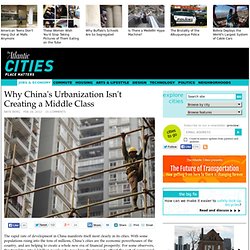

China's urbanization unlikely to lead to fast growth of middle class: UW geographer. The number of people living in China's cities, which last year for the first time surpassed 50 percent of the national population, is considered a boon for the consumer goods market.

That is based on the assumption that there will be more families with more disposable income when poor farmers from China's countryside move to cities and become middle-class industrial and office workers. But the assumption overlooks a policy from the era of Chinese leader Mao Zedong that restricts the upward mobility of its rural citizens, says a University of Washington geographer. This calls into question China's strength in the global market and its ability to overtake the United States as a global superpower, according to Kam Wing Chan, a UW professor of geography.
His findings are published in the current issue of the journal Eurasian Geography and Economics. China facts: MEGA-CITIES & URBANIZATION. China Mike’s 100% verified, no B.S.

China facts (interesting & fun statistics): China’s urban population: 43% of total population (2008 estimate: CIA World Fact Book)Rate of urbanization: 2.7% annual rate of change (2005-10 estimate: CIA World Fact Book) Top 10 most populous Chinese cities: (metro area populations, 2010-2011) Shanghai (上 海): 18,000,000 Beijing (北 京): 13,200,000 Guangzhou (广 州): 12,000,000 Shenzhen (深 圳): 8,615,000 Tianjin (天 津): 8,200,000 Chongqing (重 庆): 7,500,000 Hong Kong (香 港): 7,055,071 Dongguan (东 莞): 6,950,000 Nanjing (南 京): 6,800,000 Wuhan (武 汉): 6,600,000 [Source: Wikipedia “List of cities in the People's Republic of China by population”] Click here for my Chinese major cities and population density maps.Shanghai was ranked #1 as the best city in mainland China for doing business.
Two-thirds of China’s population—an estimated 64%—will live in cities by 2025. [ McKinsey & Co. report "Preparing for China's urban billion" March 2009 ] Urbanization in China. China's urbanization rate to further boom. Preparing for China's urban billion. The scale and pace of China's urbanization continues at an unprecedented rate.

If current trends hold, China's urban population will hit the one billion mark by 2030. In 20 years, China's cities will have added 350 million people more than the entire population of the United States today. By 2025, China will have 221 cities with one million–plus inhabitants—compared with 35 cities of this size in Europe today—and 23 cities with more than five million. For companies in China and around the world, the scale of China’s urbanization promises substantial new markets and investment opportunities. Video. Why China's Urbanization Isn't Creating a Middle Class - Jobs & Economy.
The rapid rate of development in China manifests itself most clearly in its cities.

With some populations rising into the tens of millions, China’s cities are the economic powerhouses of the country, and are helping to create a whole new era of financial prosperity. For some observers, this translates into 1.3 billion people who now have the money to afford the sort of commercial goods many of the country’s factories had previously been producing for the affluent populations of other countries. China is seeing its own affluence rise, and some surmise that this will translate into a Western-style nation of relatively well-off consumers; that, as this report from the McKinsey Global Institute suggests, China’s middle class is emerging to help propel the country’s economic success even higher.
The only problem is that this middle class doesn’t actually exist. And unless decades-old rules change, it won't. “After a quarter century of development, it still remains very much a migrant city. China’s Urbanization: It Has Only Just Begun. In May, disgruntled workers of Honda factories in Zhongshan, southern China, went on strike at the Honda Lock auto parts factory and started posting accounts of the walkout online, spreading word among themselves and to workers elsewhere in China.

In June, Bloomberg reported that China, “once an abundant provider of low-cost workers, is heading for the so-called Lewis turning point, when surplus labor evaporates, pushing up wages, consumption and inflation.” China had depleted its surplus labor; the period of cheap labor was over. In the subsequent debate, some observers concurred with the observation that a turning point had arrived in China. Others noted that the conclusion is too simplistic because it does not fit into the big picture of China’s demography. With the gloomy economic prospects in the advanced economies and relatively strong recovery in the large emerging economies, the debate is about to resurface.